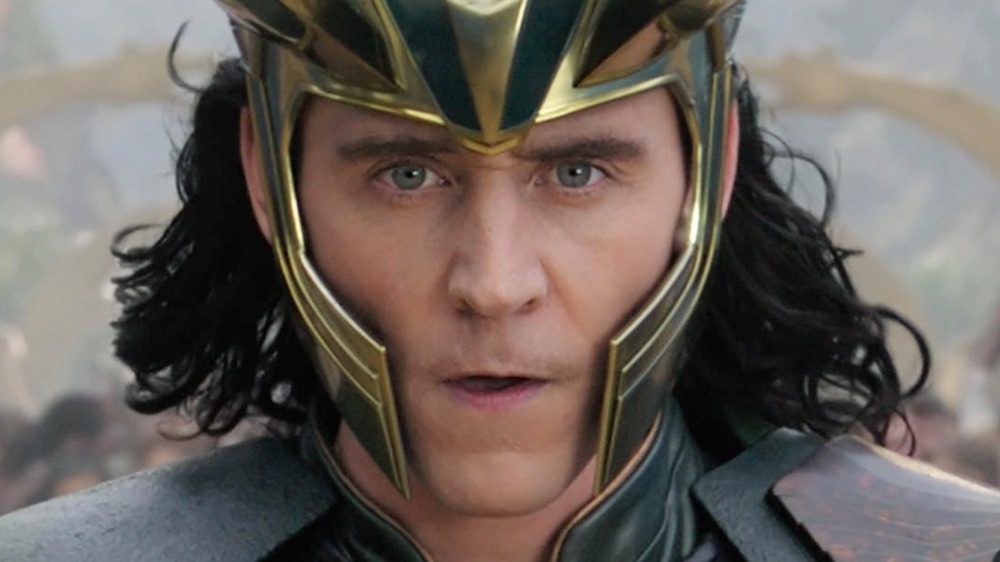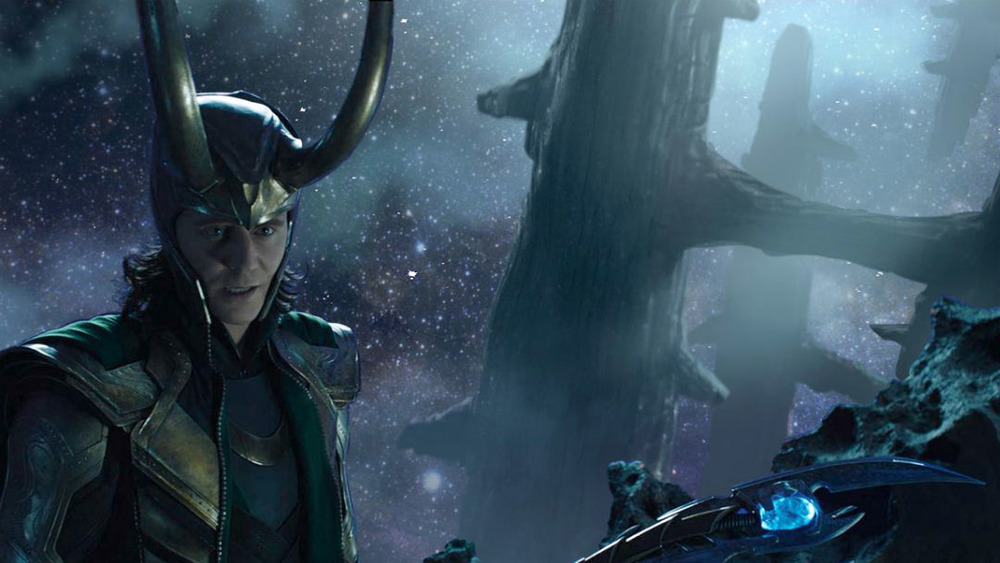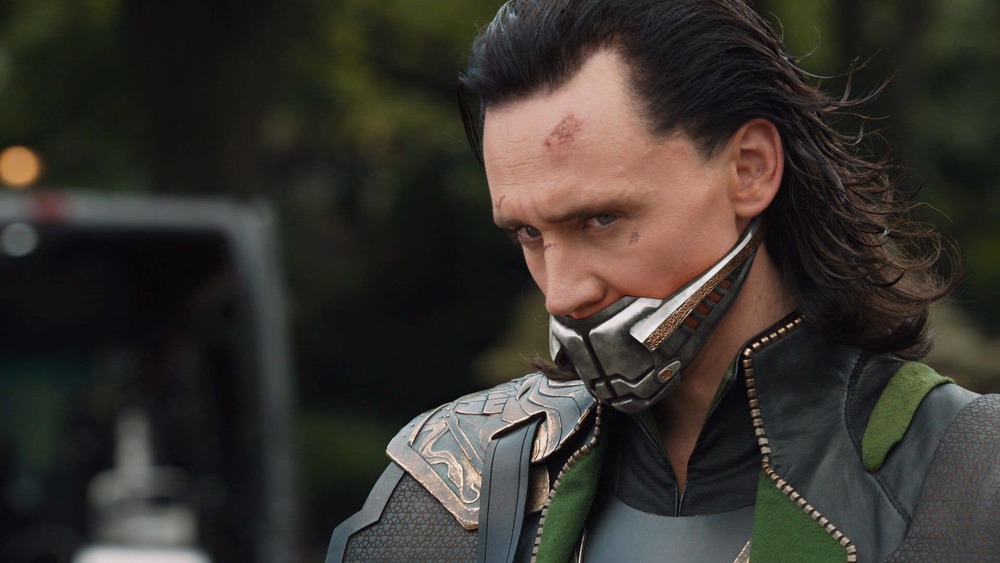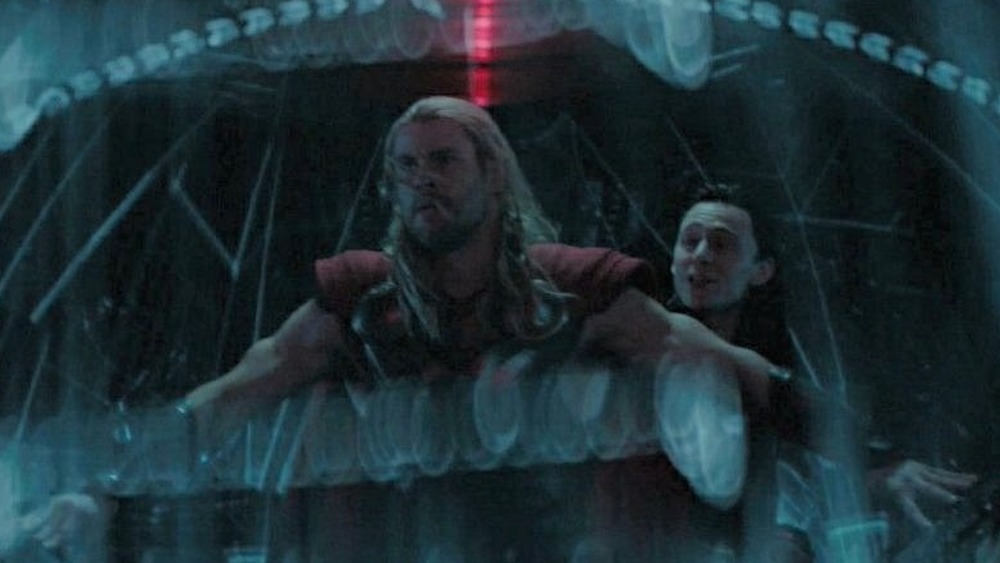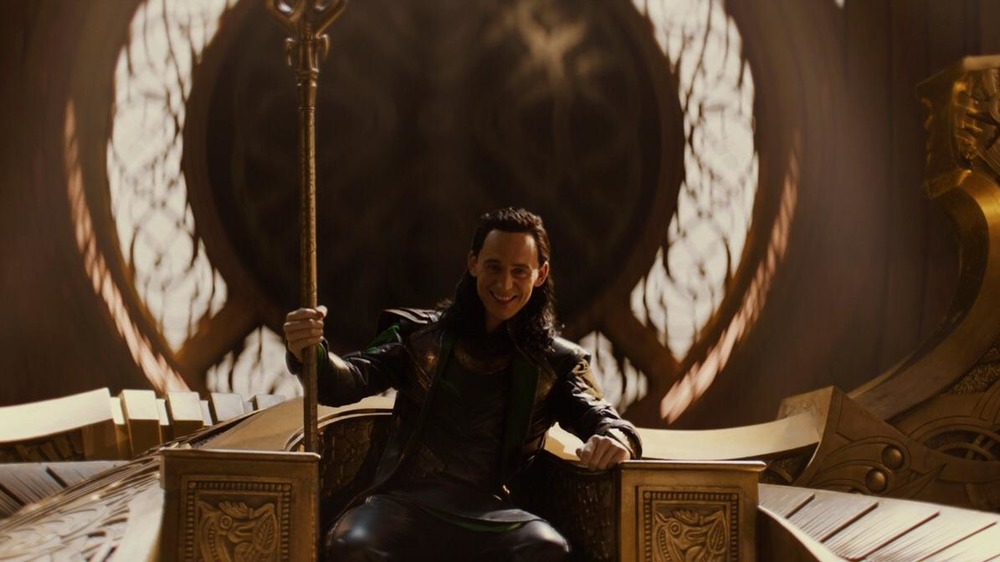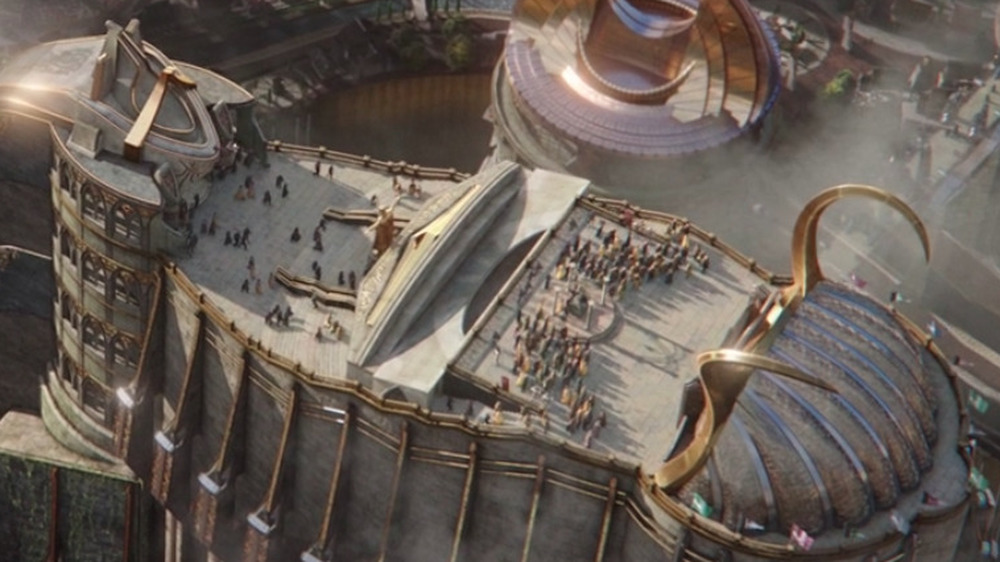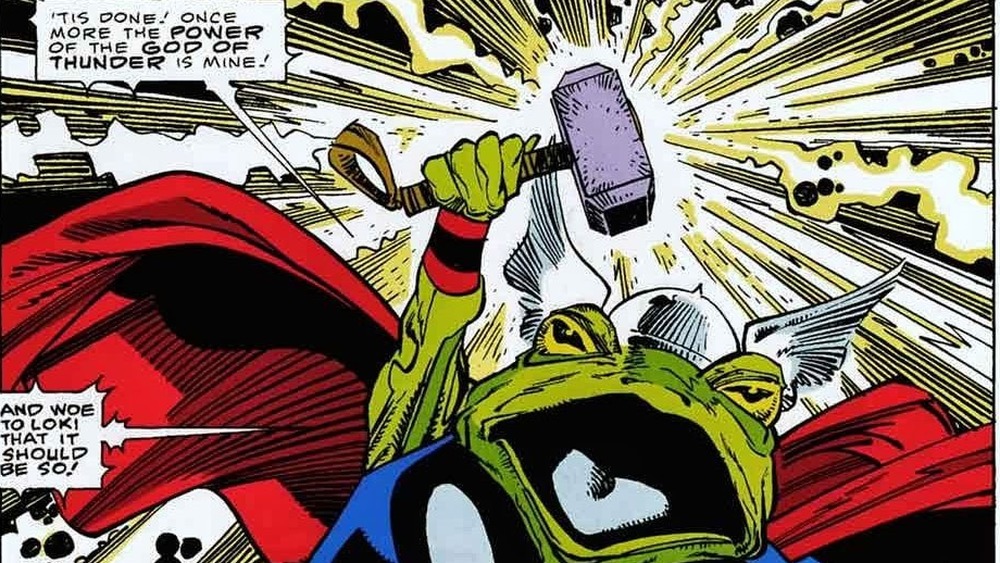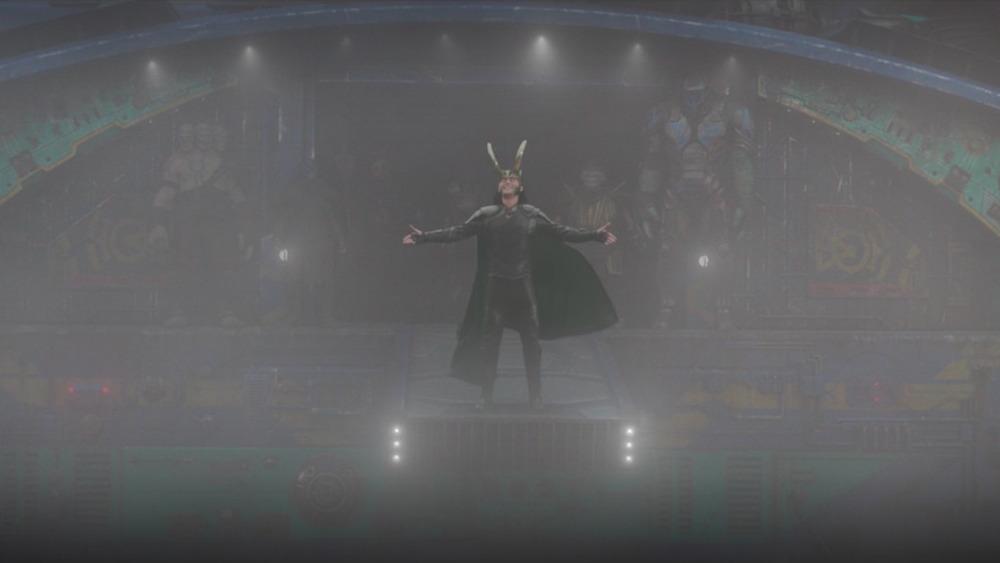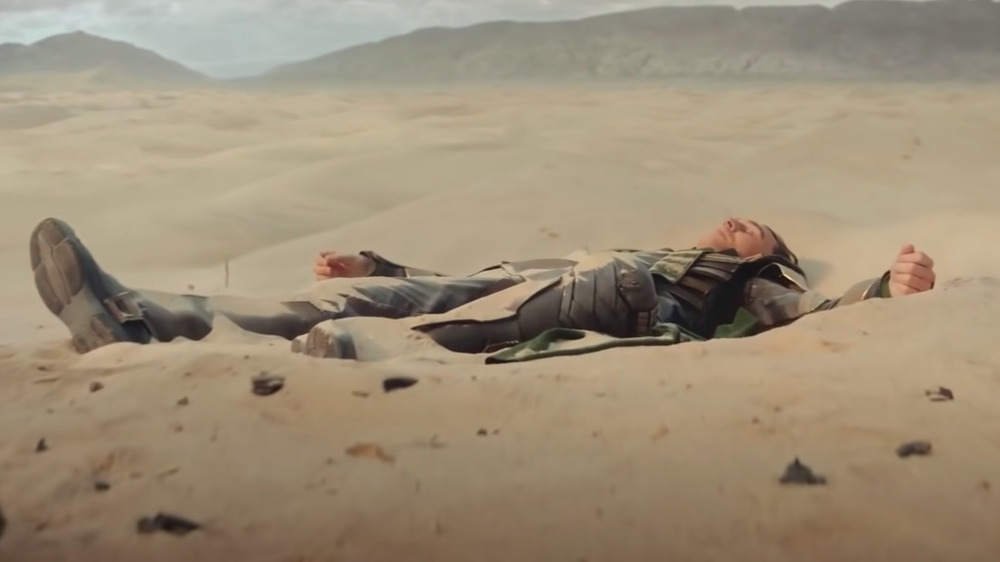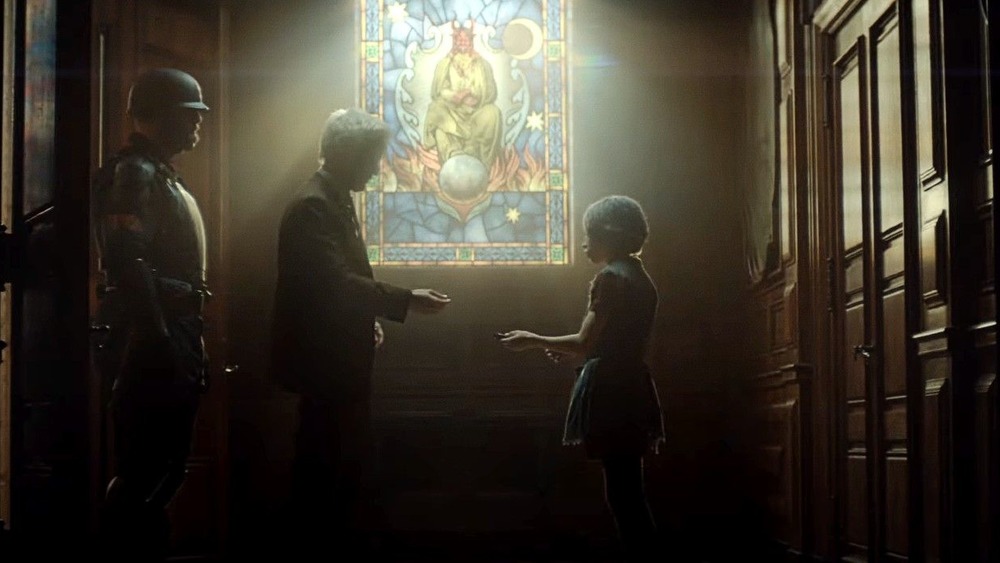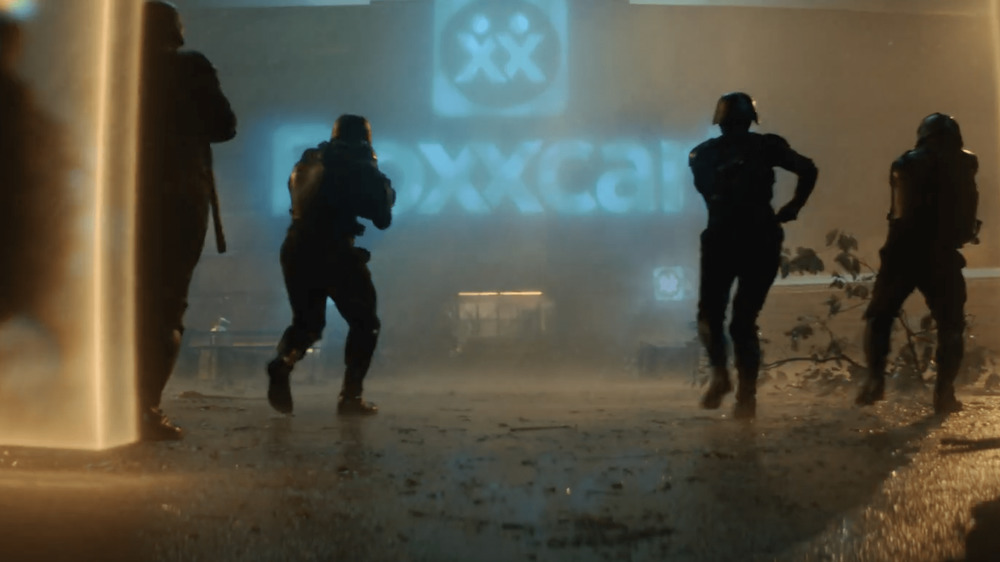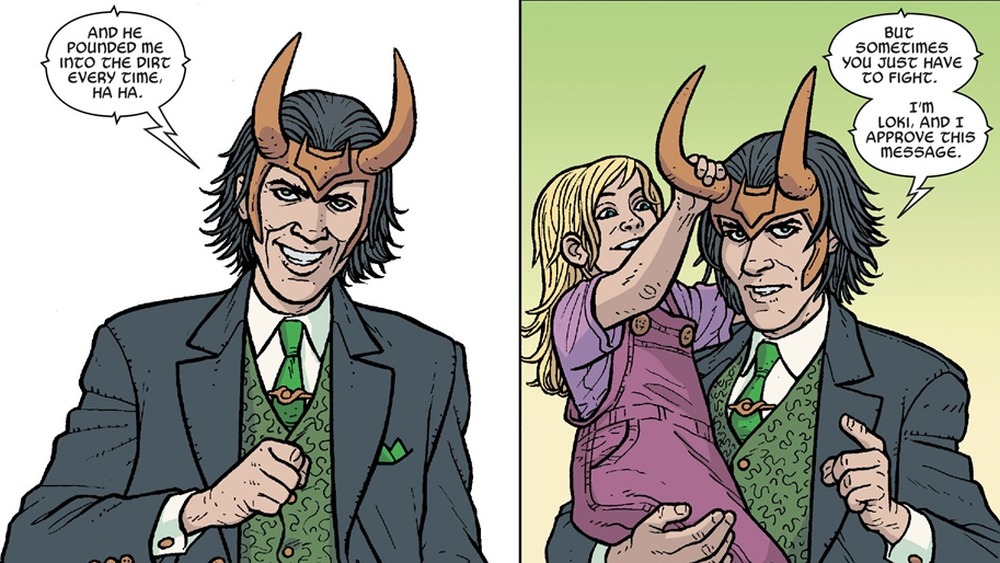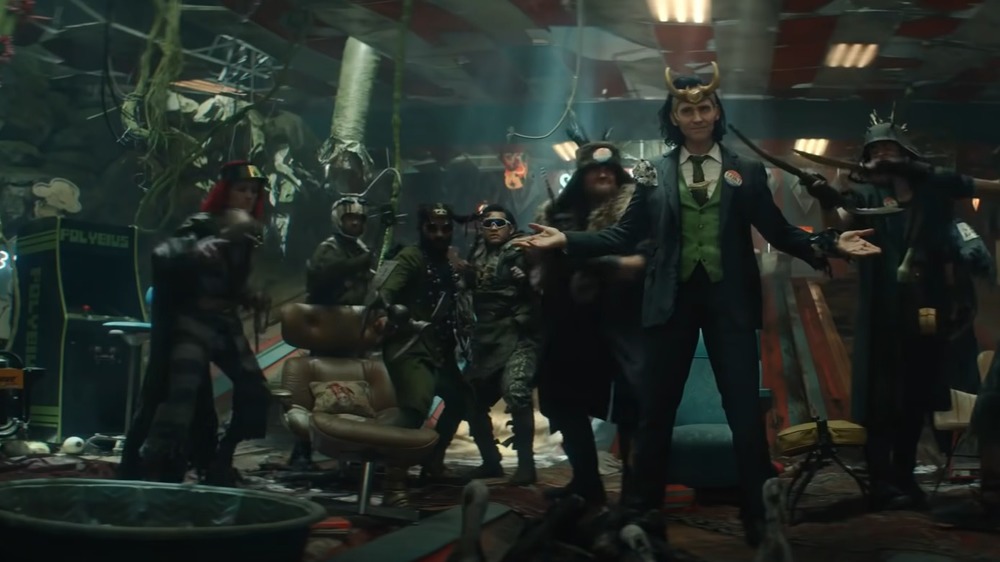The Best Loki Easter Eggs In The MCU
Whether he's invading New York or fighting alongside the Revengers, Loki is one of the Marvel Cinematic Universe's most beloved characters. As played by Tom Hiddleston, he's the Norse god of mischief and a trickster with a complicated family tree. He spent most of his life believing he was the biological son of Odin (Anthony Hopkins) and living in the shadow of his brother, Thor (Chris Hemsworth), before discovering he was adopted from his father's ancient enemies, the Frost Giants. Since then, he's bedeviled both Thor and the Avengers across the franchise's history, nearly destroying more than one world in the process. And yet audiences still love him for his inner turmoil, charm, cleverness, and all-around sneakiness.
So it only makes sense that Loki would sneak in some private little jokes right under most viewers' noses. We've looked through all his appearances to find the best examples, and here we have the greatest inside gags, hidden background details, and Easter eggs from Loki in the Marvel Cinematic Universe.
Thanos threatens Loki with his mythological fate
After seemingly falling to his doom in Thor, Loki reappears as the primary villain of The Avengers. Or at least, he seems to be. He's actually leading an invasion of Earth on behalf of a mysterious figure we never see until the post-credits teaser reveals him as Thanos, laying the groundwork for Avengers: Infinity War six years down the road.
Thanos relays his messages to Loki through a hooded character called the Other (Alexis Denisof), who wants to make sure Loki understands how seriously Thanos takes his mission. "If you fail ... there will be no realm, no barren moon, no crevice where he cannot find you. You think you know pain? He will make you long for something sweet as pain." And while the Other delivers his menacing a monologue, a snakelike creature slithers meaningfully in the background.
Loki doesn't need to be told twice. In the Elder Edda, the gods punish Loki for killing Odin's favorite son, Baldur, by tying him to a rock with his own kid's intestines while a snake hangs above him, dripping venom onto his face. Loki's wife, Sigyn, catches the toxins in a basin, but every once in a while, she has to leave to empty it, and the venom falls on Loki's face so painfully that he shakes the whole Earth. The snake in Avengers may have been a reminder, both to Loki and us, of just how much pain he's endured in the past. And if Thanos can come up with torture worse than that ... yikes.
Loki's muzzle calls back to the Norse legends
In the end of The Avengers, the heroes save the day and capture Loki so Thor can extradite him to his home in Asgard to face Odin's justice. As Thor carries his brother away, he's locked up not just with cuffs on his wrist but a muzzle on his mouth. That seems fitting for a character who does so much damage with just his words, and it's even more fitting when you know a little about your mythology.
In medieval historian Snorri Sturluson's Younger Edda, Loki thinks it'd be a good idea to shave all of Sif's (Thor's wife) hair. When the other gods catch him, Loki agrees to commission the dwarfs to make Sif more hair out of gold. Loki offers to pay with his own head, and the dwarfs get to work making not just making a headdress for Sif but also a spear for Odin and Thor's hammer, Mjolnir. When it comes time to pay, Loki agrees, but he reminds the dwarfs the deal is only for his head, and if the dwarfs take off any of his neck along with it, the bargain is void.
The dwarfs have no choice but to let Loki go, but they still get back at him by sewing his mouth shut to keep him from smooth-talking anyone else again. Loki's muzzle in The Avengers looks a lot less painful than that, but the parallel should be clear.
Thor really did kill his grandfather in the comics
Thor and Loki end up on the same side in Thor: The Dark World when a new enemy, the Dark Elf Malekith (Christopher Eccleston), arrives planning to destroy Asgard and the rest of the Nine Realms. In the process, he kills Thor's mother, Frigga (Rene Russo). This leads to Odin's decision to lock down Asgard, but it only makes Thor more determined to hunt down Malekith. He needs a way around Odin's defenses, and who better than the sneakiest god alive?
Thor and Loki commandeer one of the Dark Elves' ships from the Asgardian impound. Unfortunately, Thor doesn't turn out to be much of a pilot for anything more complicated than a flying hammer. As Thor sideswipes one of Asgard's monuments, Loki quips, "Well done, you've just decapitated your grandfather."
It's a brief throwaway line, but comics fans may recognize its deeper significance. In 2009's Thor #600, Thor really does kill his own grandfather — thanks to Loki, of course. The god of mischief travels thousands of years into the past to trap the soul of Thor's grandfather, Bor, in the snow, then returns to resurrect him ... but not before scrambling Bor's mind so he'll attack everything in sight. As Bor rampages through New York, Thor finally realizes there's no way to stop him except by killing him — all according to Loki's plan, since the penalty for killing Asgardian royalty is exile.
The score to Dark World goes to the source for one track title
Marvel loves sneaking in Easter eggs so much that they're not content to stop with the movies. Even the tracklist to Thor: The Dark World manages to squeeze in a reference that goes back beyond Loki's comic book history to the original Norse texts. Composer Brian Tyler includes Loki's theme on the album, named "Lokasenna." It may seem like a bunch of random letters attached to Loki's name at first glance, but it actually comes from one of the earliest surviving references to the character, an Old Norse poem collected in the Elder Edda.
Even in the Middle Ages, the Loki we know and love was already fully formed, and the poem tells of him getting kicked out of a party hosted by the sea god Aegir for murdering another of the guests, then returning to pick fights with other gods and accusing them of all kinds of crimes. Finally, Loki politely excuses himself when Thor threatens to shut him up with his hammer.
Loki customized his stage in Ragnarok
The end of The Dark World reveals that Loki didn't actually die in his battle with the Dark Elves. In fact, the Odin that Thor has been asking permission to return to Earth is actually Loki in disguise. So, when Thor returns from his journeys across the universe in search of the Infinity Stones in Thor: Ragnarok, he gets to see what Loki has been up to in his absence.
Still pretending to be Odin, Loki is putting on a play that tells the story of his supposed heroic death, with Chris Hemsworth's brother, Luke, as Thor and Matt Damon as Loki. (Presumably, they're playing Asgardian actors, but we wouldn't put it past Loki to kidnap mortal movie stars to fan his ego.) Before we see what's going on, we get a brief look at the stage itself as Thor flies over the Asgardian skyline. The design fits the vanity of the whole project — the whole thing's a gigantic recreation of Loki's own golden helmet with its distinctive curved horns.
The god of mischief really did turn Thor into a frog
In Thor: Ragnarok, Loki's self-congratulatory play proves that he's probably better off sticking with supervillainy than writing. As Matt Damon plays Loki's drawn-out death scene, he uses his last words to atone for all his regrets, including the events of The Avengers and "that time [he] turned [Thor] into a frog."
Surely something that silly couldn't have been an actual story in the comics, could it? Well, it was, and a darned good one, too. In the '80s, writer-artist Walt Simonson took the reins of Thor with an appropriately grandiose, mythic take on the character, one full of new worlds, epic battles, and poignant deaths. But he wasn't above a little change of pace to lighten things up a bit. In Thor #364, Loki's latest power play involves transforming his brother into an amphibian. Thor doesn't let that stand in the way of his heroism, though, and he aids a colony of Central Park frogs with names like Puddlegulp and Gullywhump in their war against the rats before returning to Asgard.
Eventually, of course, everything goes back to normal. But the idea of a frog Thor obviously caught fans' imaginations because not only is the story movie canon, Lockjaw and the Pet Avengers #1 actually gave Puddlegulp the power of Thor. He'd offhandedly mentioned in the original story that he'd once been a man until he ticked off the wrong witch, and Pet Avengers reveals his human name — Simon Walterson.
Loki follows his destiny in a very different way than the Vikings predicted
Thor: Ragnarok takes a much more lighthearted approach towards the apocalypse than Norse mythology does, but the film does deliver on the destruction of Asgard. In order to keep Thor and Loki's sister, Hela (Cate Blanchett), from using Asgard's power to conquer the rest of the universe, our heroes have to totally annihilate their home.
However, before that final showdown, Hela tosses Thor and Loki into a vortex that drops them on the alien planet of Sakaar. Along the way, they make some new allies and meet an old friend (well, not in Loki's case), and they eventually oust the dictatorial Grandmaster (Jeff Goldblum). Of course, with Loki being Loki, he tries to betray his brother, but Thor gets the drop on him, abandoning him on Sakaar as he pilots the Grandmaster's ship back to Asgard.
But when Thor arrives, the goddess of death proves to be a handful for her brother and his pals. Things look grim for our hero, but that's when Loki shows up in a massive ship, accompanied by Sakaaran gladiators. As Asgardian refugees flee Hela and seek refuge on Loki's new ship, the god of mischief welcomes them aboard ... but not, of course, without taking an undue amount of credit for himself.
Interestingly, the Younger Edda also says Loki will arrive at Ragnarok at the helm of a ship, in this case one called Naglfar that he's built from the nails of the dead. In Norse mythology, Loki comes bringing destruction instead of salvation, but Thor: Ragnarok's writer-director, Taika Waititi, cleverly flips the script to suit his more sympathetic interpretation of the character.
Loki recreates Iron Man's crash landing
Loki is finally getting a series all his own on Disney+, and even though we've only seen a three-minute trailer as of this writing, it's already packed full of Easter eggs. The clip opens with the scene of Loki stealing the Tesseract in Avengers: Endgame before revealing what happens next, as the space-warping artifact drops him somewhere in the Gobi Desert.
That shot should look very familiar to Marvel fans. It comes from the very beginning of the MCU, right after Tony builds his original power armor and escapes a cave full of terrorists. Upon making his escape, Tony crash-lands in the desert, in a very similar to pose that Loki adopts in the Disney+ trailer. In light of that, the Mongolian dress of the people who discover the trickster god may also be significant. After all, Raza (Faran Tahir), the man who forced Tony to build his suit, claimed to be descended from the Mongolian emperor Genghis Khan.
How much is that Mephisto in the window?
Some of the Easter eggs in the Loki trailer will take a quick mind and a quick finger on the pause button to spot. In one apparently insignificant scene of Mobius M. Mobius (the Time Variance Authority agent played by Owen Wilson) handing an unknown object to a child, you can see a stained-glass window with an image of a demon. That's nothing new as far as portrayals of the devil go, but the wild hair and red skin look an awful lot like Marvel Comics' favorite evil entity, Mephisto.
Stan Lee and John Buscema's Silver Surfer drew many parallels between their cosmic hero and Jesus, and that meant they needed their own version of the temptation in the wilderness. So in Silver Surfer #4, they introduced Mephisto to offer him anything he wanted in return for his soul. Since then, Mephisto has become one of the most important villains in the Marvel Universe, and creators have revealed his major roles in the origins of Doctor Doom and Ghost Rider.
Now that the Avengers have beaten Thanos, few other villains seem like they could unite the whole universe against them in Phase 4 quite as well as Mephisto. Whether or not this cameo is his only contribution to Loki, we're sure the new series will only add fuel to the Mephisto fire.
Roxxcart comes straight from the comics
A brief scene in the Loki trailer teases a SWAT team, possibly the Time Variance Authority, assaulting an abandoned, futuristic supermarket called "Roxxcart." It's obviously a rhyming, lawyer-friendly stand-in for Wal-Mart, but comics fans should recognize some deeper significance than that. Roxxmart is apparently a subsidiary of Roxxon, Marvel's go-to evil corporation ever since Steve Englehart first referenced it in his script for Captain America #180 almost 50 years ago. Since then, it's expanded from a thinly disguised equivalent of our universe's oil company Exxon to every industry imaginable, including Roxxie Burger, Roxx News, and, apparently, Roxxmart.
It's also an appropriate location for a Loki series, since writer Jason Aaron began tying Roxxon to the Asgardian side of the Marvel Universe in Thor: God of Thunder #19, which introduced new CEO Dario Agger when S.H.I.E.L.D. environmental agent Roz Solomon got Thor to help her take down one of Roxxon's factories. The encounter opened Dario's eyes to the potential of the other realms, and in return for mineral rights, he helped Malekith conquer them, eventually leading to 2019's massive War of the Realms crossover. Dario also has a mythological connection of his own — he can transform into the bull-headed Minotaur of Greek legends. Seems like the kind of villain who could give Loki some trouble — could Roxxmart be paving the way for his appearance?
The Loki trailer references the Vote Loki comics
The trailer for Disney+'s Loki ends with the god of mischief and what look to be some post-apocalyptic scavengers, and Loki is dressed in a horned tiara and a suit with a Loki campaign button pinned to the lapel. This is the showrunners' nod to Christopher Hastings and Langdon Foss' 2016 miniseries Vote Loki. In fact, it's a remarkably close recreation.
Besides the button, Loki's also wearing the tiara he wore in the series (from the costume Jamie McKelvie designed for writer Al Ewing's Loki: Agent of Asgard), and he's even sporting the very same black suit coat and matching green vest and tie the trickster wore in Vote Loki #2, even if they're a little worse for wear after some time in the wasteland of the future. As for the comic itself, it features Loki's presidential campaign, which gets up a surprising amount of momentum despite the efforts of muckraking journalist Nisa Contreras and, well, the fact that it's Loki.
Loki somehow got his hands on an urban legend
The last scene of the Loki trailer takes place in a scavengers' den full of odds and ends, cluttered enough that you might miss something significant to people who love conspiracies. There's an arcade box leaning against the wall labeled Polybius, and while there's no real game with that title, a whole lot of people believed there was back in the '80s.
According to Portland Monthly, a mysterious black box appeared with no explanation in arcades around the city. As if that wasn't ominous enough, the game was frighteningly addictive. Kids who played it disappeared, and mysterious men wearing black suits would occasionally show up to service the machines. One "survivor" described his experience to the Polybius Conspiracy podcast, saying he was abducted, drugged, and led through a tunnel network underneath Portland. He was finally discovered in a forest 60 miles away. Even though the arcade cabinet was blank, conspiracy theorists started referring to the cursed game as Polybius.
Okay, granted, no one's ever proven the game has existed, but this is a fun Easter egg, nevertheless. Loki's copy obviously can't be the real one since it has a label, but it does suggest his time-traveling shenanigans may be the answer to the mystery, especially since the D.B. Cooper tease suggests the series will be having some fun using Loki's presence to explain some classic urban legends.
